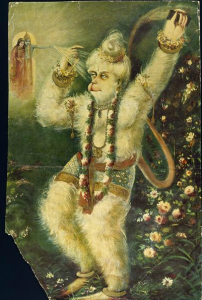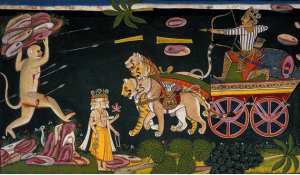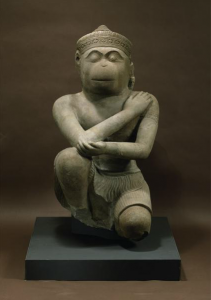The, Ramayana, by Valmiki is a sacred Hindu text that is known throughout the world for a multitude of reasons, but the main reason being that it is entertaining for both Hindus and non- Hindus to read. In numerous Hindu texts such as the Ramayana, animals are often portrayed as the main characters as well as deities. For example, one of the most widely written about animals in Hinduism is the monkey, and monkeys are portrayed as wise, strong creatures. Some of the other praised animals include cows, birds, and snakes; each of these animals denotes special symbols. These animals not only play a pivotal role in the outcome in the ancient Hindu epics, but these stories also affect the daily lives of Hindus; many people will try to live up to these characters’ roles and follow their actions. In Valmiki’s, Ramayana, one of the main heroes of the story is a monkey named Hanuman, and he changes the outcome of the entire epic. Even though the story of the Ramayana is globally acknowledged as the story of Rama, it could be recognized as the story of Hanuman; in my opinion, he ultimately is the main character, and if he was not present the outcome of the Ramayana would be completely different. Hanuman affects characters both in and outside of the story, and that’s why I think he should be considered the hero.
Hanuman’s bravery and courageousness are characteristics that set him apart from the other characters in the Ramayana. Unlike many other characters, Hanuman can be trusted with any task and never disappoints, and this characteristic influences how Hindus worship him. Philip Lufgendorf has written widely on Hanuman and his role as a deity. He describes Hanuman by stature,
“There is no task in the world he can’t accomplish…Young and old feel themselves safe and secure by remembering him. Although he is incomparable in the realms of courage, valor, heroism, splendor, and intensity, Hanuman is very simple-hearted, compassionate, and detached. He had no desires of his own” (Lufgendorf 25).
Lufgendorf thinks Hanuman is highly praised because he is heroic and very selfless; he willingly puts himself in danger in order to protect others. I agree with Lufgendorf’s thoughts because in order to rescue Sita, Hanuman had to take many drastic actions, such as crossing the ocean to Lanka. His actions are described clearly: “Then without pausing to think he drew in his neck, laid back his ears and jumped” (Buck 225). When William Buck describes the actions of his ears pulling back, it reminds the audience that even though Hanuman obtains human like characteristics, ultimately he still is an animal. Jumping across an entire ocean is a very brave action, but since Hanuman is Rama’s devotee, he willingly puts himself in danger to make Rama happy. Therefore, to me, this action ultimately changed my opinion about Rama being the main character. I feel like Hanuman puts himself at risk much more often than Rama does, thus providing him with heroic qualities.
Furthermore, he contains an immense amount of physical power, which is why Rama called upon him to rescue his wife, Sita. When Hanuman leaped across the ocean, the power of his jump is clearly stated: “That white monkey was like a comet, pushing the sky from his way and bumping clouds aside” (Buck 225). His speed from the jump was so strong and fast that it allowed him to move the clouds. I wonder if the Hindus who read this epic view his actions in this scene, as not only being physically strong, but also mentally strong? In real life, statues of Hanuman are often very large to signify his divine strength because he contains so much power (Jacobsen 1). In most visual representations of Hanuman, his stature is often depicted as being gargantuan.
In the image above, Hanuman’s physical power is clearly represented; he is wounded yet still willing to fight the enemy (Lessing 1). Even though he has numerous arrows stuck in his body, he continues to fight, representing once again, his heroic qualities. Similar to the book, this image depicts Hanuman’s bravery when it comes to facing an enemy.
Therefore, to me, Hanuman ultimately is the hero of the story because he saves the main characters, Sita and Rama. Rama calls upon Hanuman to help rescue Sita because he knows Hanuman will not disappoint him. As such, Hanuman is most popularly known for his devotion to Rama and for being a leader (Wolcott 653). If Hanuman was not in the Ramayana, then no one would have been able to rescue Sita, since no one obtains enough power to destroy Ravana and his army. Even though Hanuman had been captured, he never forgot that his initiative was to rescue Sita.
Due to the fact that Hanuman has such a significant role in the Ramayana, he inspires many people who have read this epic. He shows physical and emotional strength at all times during this story, and some readers may look to Hanuman for guidance when they are in times of need. More specifically, Hanuman connects very well to children. Moussaieff Masson describes this thought when he says, “As an imaginary companion he is addressed, as it were, to children (Masson 356)”. Children have an easy time connecting to Hanuman because he is a superhero in the form of a monkey.
These animals are not portrayed as being completely animalistic; moreover, Alf Hiltebitel describes animals as being humanlike when he says, “Male animals also frequently figure in combination with human males in composite animal forms” (Hiltebitel 3989). Thus, animals and humans can be mixed together, and in some representations of Hanuman, he is described as having a monkey face with a human-like body.
Considering that Hanuman affects all the main characters in this story in various ways, the Ramayana would be an entirely different story if Hanuman was not present. In fact, the entirety of the Hindu tradition would be drastically different if it were not for animals. There would not be specific places of worship devoted to the animals, and certain animals would not be praised in society. Although the animals in Hindu literature are not human, their characters are undeniably humanlike. Thus, Hanuman’s actions in this epic ultimately make him the main character and hero because he affects all the other characters and even affects the lives of people outside of the epic.
Works Cited
Buck, William. Ramayana. Berkeley And Los Angeles, California: University Of California Press, 1976. Print.
Hiltebitel, Alf, “Hinduism: An Overview,” in Encyclopedia of Religion, 2nd Edition, ed. Lindsay Jones (Detroit: Macmillan Reference USA, 2005), 3998-4009
Knut Axel Jacobsen. “Sacred Animals.” Brill’s Encyclopedia of Hinduism. Edited by: Knut A. Jacobsen, Helene Basu, Angelika Malinar, Vasudha Narayanan. Brill Online, 2014. Reference. University of Vermont. 11 October 2014
Lessing, Erich. Hanuman, King of the Monkeys. 1653. Erich Lessing Culture and Fine Arts Archives, New York. Art Rescource. N.p.: British Library Board, n.d. N. pag. Artstor. Web. 12 Oct. 2014.
Lufgendorf, Philip. “Five Heads and No Tale: Hanumān and the Popularization of Tantra.” JSTOR. Springer, Dec. 2001. Web. 13 Oct. 2014.
Masson, J. Moussaieff. “Hanumān as an Imaginary Companion.” Journal of the American Oriental Society 101.3 (1981): 355-60. JSTOR. Web. 04 Nov. 2014.
Wolcott, Leonard T. “Hanuman: The Power-Dispensing Monkey in North Indian Folk Religion.” The Journal of Asian Studies 37.4 (1978): 653-61. JSTOR. Web. 20 Oct. 2014.



